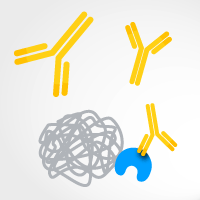iDimerize antibodies

After fusing your protein of interest to one to the dimerization tags provided with iDimerize Homodimerization Systems (DmrB) or iDimerize Heterodimerization Systems (DmrA and DmrC), you may wish to monitor the protein's expression by SDS-PAGE followed by Western blot. These sensitive antibodies give a clean band on a Western blot. The DmrA and DmrB antibodies are monoclonal mouse antibodies, and the anti-DmrC antibody is polyclonal, derived from rabbit.
Overview
- The DmrB and DmrA domains are highly homologous, so the antibodies cross-react with each others' domains
- The anti-DmrC antibody does not cross-react with the other domains
- Detection of DmrB domains used for iDimerize Homodimer Systems
- Detection of DmrA and DmrC domains used for iDimerize Heterodimer Systems
- DmrB antibody can be used for detection of DmrD domains used for the Reverse Dimerization Systems
- DmrA is identical to wild type FKBP12
- DmrB is identical to the F36V mutant of FKBP12
- DmrC is identical to the T82L mutant of FRB
More Information
Source
- DmrA and DmrB monoclonal antibodies: mouse
- DmrC polyclonal antibody: rabbit
Additional product information
Please see the product's Certificate of Analysis for information about storage conditions, product components, and technical specifications. Please see the Kit Components List to determine kit components. Certificates of Analysis and Kit Components Lists are located under the Documents tab.
Takara Bio USA, Inc.
United States/Canada: +1.800.662.2566 • Asia Pacific: +1.650.919.7300 • Europe: +33.(0)1.3904.6880 • Japan: +81.(0)77.565.6999
FOR RESEARCH USE ONLY. NOT FOR USE IN DIAGNOSTIC PROCEDURES. © 2025 Takara Bio Inc. All Rights Reserved. All trademarks are the property of Takara Bio Inc. or its affiliate(s) in the U.S. and/or other countries or their respective owners. Certain trademarks may not be registered in all jurisdictions. Additional product, intellectual property, and restricted use information is available at takarabio.com.






